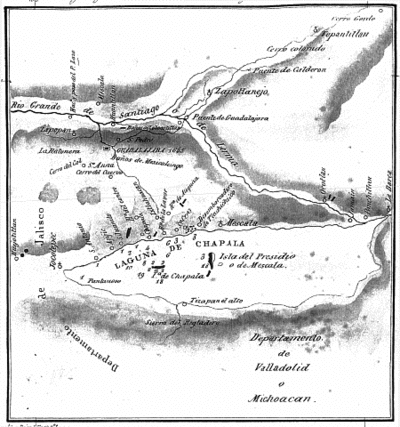Did You Know…?
The first detailed scientific account of Lake Chapala was written by Henri Guillaume Galeotti. It was based on a visit to Chapala in February-March 1837. The article was published first in French in 1839, and then shortly afterwards in Spanish in El Mosaico Mexicano. It remains unclear precisely why Galeotti prepared his excellent article devoted to the geology and natural history of the lake. He did not publish anything else based on his trips to Mexico apart from some specialist botanical papers.
Galeotti, born in Paris on September 10, 1814, studied natural history at the Establissement Géographique de Brussels, founded in 1830 by Philippe Vandermaelen, a very famous Flemish cartographer. Vandermaelen produced an extraordinary world atlas, published in 1827, with 400 maps in six volumes, covering the entire world at a uniform scale of about 1:1,600,000.
Galeotti arrived in Mexico in December 1835; it turned out to be a visit which lasted several years. Galeotti was primarily a botanist, and one of considerable note. He was responsible for the first scientific descriptions of scores of plants, including a wide variety of cacti, for which he had a particularly fondness. During his time in Mexico, Galeotti amassed an extensive collection of Mexican flora.
On his return to Europe, Galeotti decided to set up his own business, collecting Mexican cacti and importing them to Europe. He apparently revisited Mexico briefly in the winter of 1840-1841. Regrettably, tumultuous events in Europe caused the cactus venture to fail by 1849, leaving Galeotti in dire straights. He was reduced to selling some of his prize specimens, and even parts of his massive collection of more than 8,000 pressed plants from Mexico. One of his more expensive cacti had a price of 500 francs, equivalent at the time to a laborer’s salary for an entire year. In 1853, Galeotti was appointed director of the Brussels Botanical Gardens, though with only a meagre salary, equivalent to that of a head gardener. He held this post until his death in 1858.
Galeotti begins by setting the scene:
An immense quantity of water bordered to the north and south by some scarped mountains, located 14 leagues south of Guadalajara, the capital of the Department of Jalisco (formerly the province of New Galicia), and 130 leagues west of Mexico City, is known by the name Lake Chapala, derived from the name of the old village of Chapala, situated on the western shore of the lake. Excavating in the environs of the village, old Indian burial ditches, skeletons, idols, earthenware vases called cantaros, and monetary tokens of obsidian or reddish clay etc. are found.
His paper includes some detailed observations of storms and mirages:
We have observed in the lake the phenomenon of occasional waves (seiches) which are in the habit of lasting plenty of time, with one part of the water remaining calm next to the rough part. This occurs, usually, at about five in the afternoon. We noted several of these singular effects, on February 27 and 28, and in March of 1837: the weather was calm and the temperature between 18 and 22 degrees Centigrade. The phenomenon is visible on the southern shore and in Tlachichilco and Chapala. The flood water rises from one to four feet (from 33 centimeters to 1.33 meters).
We also observed on the lake the phenomenon of the “mirage” of water, this is when one part of it reflects the objects and remains calm next to another which is rough. It is seen with more frequency close to the island of Chapala, at mid-day with the weather serene and the Sun high. These two phenomena – the water movement and the mirage – are without doubt, correlated.
From time to time, very strong whirlwinds or cloudbursts agitate the lake, snatching fish from their hideouts, and hurling them onto the nearby mountains. Some have been found on quite a high mountain near Ixtlahuacan, two leagues from the lake.

This phenomenon, which causes great damage to the inhabitants of the shores, occurs usually in March, April and May, before the rainy season. It is during the same season when the waters reveal the idols and cups of the ancient Indians. The inhabitants believe that an old city was buried by a sudden flood, and at some distance from Chapala, several trunks of Sabino [Bald cypresses] (Taxodium distichum of Richard), partially covered by water, can still be found.
He pays particular attention to the varied birdlife around the lake:
A multitude of aquatic birds which feed on the insects of the lake inhabit its shores and the shores of the islands. There are two species of gulls (Larus), one cormorant (Carbo) which gives off a strong smell; they move slowly and stand in isolation on the rocks, or swim in groups of six or seven individuals, diving in order to eat the fish easily: water fowl (Fulica) which always collect in great numbers, and eat, from preference, the weeds the lake provides: herons (Ardea) of various species, including the egret walking alone along the shore, showing their white feathers and aiming their long pointed beak from time to time at the fish that are within reach, and other grey storks… and water sheep or pelicans (Pelecanus) which live on the island of Chapala, and fly in flocks of 50 or 60 individuals, at about five in the afternoon, to search for food on the shores, where some little fish called javai are abundant. The pelicans are very fierce and plump, and have white feathers with a yellowish green tint at the tips of their wings. Similarly, there are diving ducks (Colymbus) which hide in the water at the slightest noise: others called alcaldes, brown and small, that are not very common in the environs of the island of Chapala, royal plovers (Charadrius) and of a beautiful white color with red, curved beak; rose-colored spoonbills (Platalea), of the island of Chapala, where they are very rare, since I believe they emigrate from tropical areas in the months of June and July: night-herons (Árdea nycticorax) that have on their heads three or four fine feathers, long and flexible: there are many on the island of Chapala: green kingfishers (Alcedo) and a multitude of ducks and herons that vary enormously in color, size and species.
Galeotti reports that he sent “an almost complete collection of these birds” back to Vandermaelen in Brussels, and then turns his attention to the fish:
There is a great diversity of fish in the waters of the lake. The whitefish and the bagoc are very well-liked for the table. A great quantity of fish is caught in Easter week. The inhabitants of the vicinity subsist on little else apart from the product of this fishing, for which they prepare by building reed shacks on the shores of the lagoon, and lighting large bonfires between 6 and 7 in the evening to attract the fish. Some small tortoises (Testudo) are frequently seen, warming themselves in the sun on top of rocks; but they hide at the slightest noise. Near Lake Chapala are found small crabs, two to three centimeters, with clearly unequal pincers and some molluscs such as Unios (We have not managed to collect even one in good condition.) Planorbis and Lymnaea, which are not found whole, which we attribute to the force with which they are washed up.
He next provides a list of land-based fauna:
In the vicinity of the lake many animals are abundant, such as wolves (Cani lupus), rabbits, hares (Lepus), foxes (Cani) that the natives call coyotes: lions (Felis puma leones): brown and red squirrels (Scicirus), and skunks (Viverra) which give off an unsupportable stench. In the not very thick woods are beautiful coas (Trogon), misanthropic birds: very loud and agile blue jays (Corvus), which perch on the elevated trees, moving their long tails, and also brown-colored birds (Cuculus cayanus). On the sides of the hills are owls and burrowing owls (Strix) which live in hollows they make in the ground: clouds of robins (Turdus) and green and violet grackles; sparrows (Fringilla) with thick blue beaks; pheasants (Fatianus) etc. Snakes and insects are very rare, and sometimes some dragonflies are obtained.
After dismissing the vegetation on the hills surrounding the lake as “unremarkable”, he offers an evocative description of the area’s beautiful scenery:
There is a sublime view of the lagoon from the summit of the mountains located north of the hacienda of La Labor. To one side is revealed an immense spread of water with its islands and rock-covered shores, white villages, fishermen’s huts, the prison building, haciendas, fertile shores covered in maize and chickpea fields, large herds of cattle grazing on the plains, streams shaded by willows and Cinerarias and the snow-capped summit of Colima volcano, which stands out from the mountain range to the SSW. Canoes formed from tree trunks fly over the smooth or lightly rippled surface of the lagoon in which a blue sky is reflected. The sombre mountains of Tizapan in the SSE and SE belong to the Department of Michoacán. The ends of the lagoon are hidden by the haze. In the other direction, the rich and fertile plains of Ixtlahuacan and Atequiza, together form a combination that enchants the naturalist and landscape artist who leaves the arid valleys of Guadalajara to enter this chain of mountains, from where the views extend towards an ever-cheerful horizon.
Galeotti describes the geology and fossils of the area in similar detail. All in all, his article is a remarkable achievement for its time, a true testimony to the powerful pull that Lake Chapala has had on so many foreign visitors.
Galeotti, H. G. 1839 Coup d’oeil sur la Laguna de Chapala au Mexique, avec notes géognostiques. Translations by the author; all rights reserved.
- Based on chapter 21 of Lake Chapala through the ages; an anthology of travelers’ tales (Sombrero Books, 2008)
Related articles:
- Trade in Mexico’s cacti grew in the 1840s
- An early ascent of Mexico’s highest peak, El Pico de Orizaba

